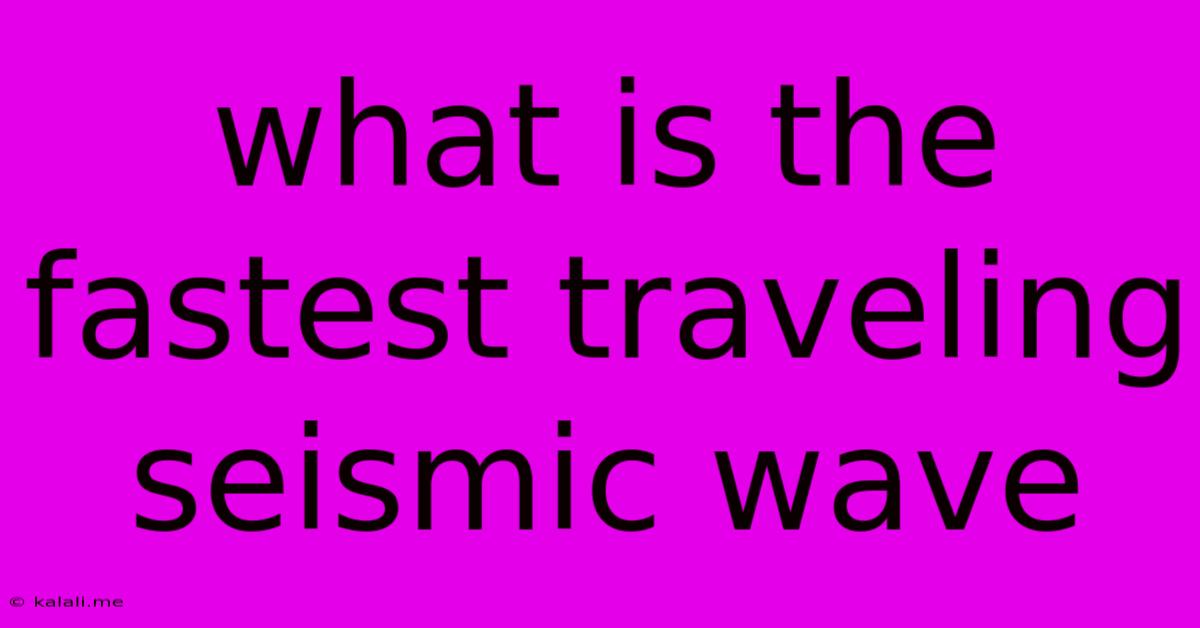What Is The Fastest Traveling Seismic Wave
Kalali
Jun 15, 2025 · 3 min read

Table of Contents
What is the Fastest Traveling Seismic Wave?
Earthquakes, those powerful manifestations of tectonic plate movement, generate various types of seismic waves that travel through the Earth's interior. Understanding these waves is crucial for seismologists to locate earthquake epicenters, assess their magnitude, and ultimately, contribute to earthquake early warning systems. Among these waves, P-waves, or primary waves, are the undisputed speed champions. This article delves into the reasons why P-waves are the fastest seismic waves and explores their characteristics.
P-waves are compressional waves, meaning they travel by compressing and expanding the material they pass through, similar to sound waves. This compressional motion allows them to move through both solid and liquid materials, unlike other seismic waves. This ability to traverse diverse mediums contributes significantly to their speed. Their speed is also influenced by the density and elasticity of the material they are traveling through. Denser, more elastic materials facilitate faster propagation. The speed of P-waves varies depending on the Earth's composition, generally ranging from approximately 6 to 8 kilometers per second in the Earth's crust.
Understanding Seismic Wave Types: P-waves vs. S-waves vs. Surface Waves
To fully appreciate the speed of P-waves, it's helpful to compare them to other types of seismic waves:
-
P-waves (Primary Waves): As discussed, these are compressional waves and are the fastest. They arrive first at seismograph stations.
-
S-waves (Secondary Waves): These are shear waves, meaning they travel by causing particles to move perpendicular to the direction of wave propagation. S-waves are slower than P-waves and cannot travel through liquids.
-
Surface Waves: These waves travel along the Earth's surface and are generally slower than both P-waves and S-waves. They are responsible for much of the damage associated with earthquakes. Examples include Love waves and Rayleigh waves.
Why P-waves are the Fastest: A Closer Look
The superior speed of P-waves stems from their compressional nature. Compressional forces can be transmitted more readily through a material than shear forces (as in S-waves). Think of pushing a series of tightly packed marbles: the compression propagates quickly down the line. This is analogous to how P-waves travel. The fact that P-waves can travel through both solids and liquids further enhances their speed advantage, as they can traverse a wider range of Earth's interior layers without interruption.
The Significance of P-wave Speed
The significant speed difference between P-waves and other seismic waves is vital for earthquake monitoring and early warning systems. The time difference between the arrival of P-waves and S-waves at a seismograph station allows scientists to calculate the distance to the earthquake's epicenter. This information is crucial for quickly assessing the earthquake's magnitude and potential impact. Faster detection via P-waves provides precious time for issuing early warnings, potentially saving lives and mitigating damage.
Conclusion
In summary, P-waves are the fastest traveling seismic waves due to their compressional nature and ability to propagate through both solid and liquid materials. This speed advantage makes them invaluable tools for seismologists, playing a pivotal role in understanding earthquakes and developing life-saving early warning systems. Their characteristics, contrasted with S-waves and surface waves, highlight the importance of seismic wave velocity in earthquake science and hazard mitigation strategies.
Latest Posts
Latest Posts
-
Distinguish Between Sampling And Non Sampling Errors
Jun 15, 2025
-
Which Of The Following Contains Both Ionic And Covalent Bonding
Jun 15, 2025
-
Consider The Parallel Plate Capacitor Shown In The Figure
Jun 15, 2025
-
Factors Of 225 That Add Up To 30
Jun 15, 2025
-
Bond Order Formula For Resonance Structures
Jun 15, 2025
Related Post
Thank you for visiting our website which covers about What Is The Fastest Traveling Seismic Wave . We hope the information provided has been useful to you. Feel free to contact us if you have any questions or need further assistance. See you next time and don't miss to bookmark.